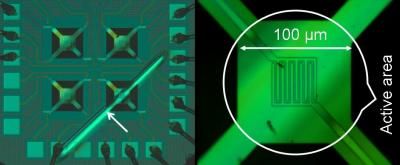New insights into the 'smell of death' could help recover bodies in disasters and solve crimes
Advertisement
In an advance toward the first portable device for detecting human bodies buried in disasters and at crime scenes, scientists report early results from a project to establish the chemical fingerprint of death. Speaking here at the 238th National Meeting of the American Chemical Society (ACS), they said a profile of the chemicals released from decomposing bodies could also lead to a valuable new addition to the forensic toolkit: An electronic device that could determine the time elapsed since death quickly, accurately and onsite.
Today, cadaver dogs are the gold standard for detecting and recovering bodies in earthquakes, tornadoes, hurricanes, and other natural disasters. "These dogs are highly effective, but it takes lots of time, expense and manpower to train them. If there was a device that was as effective for a fraction of the cost, that would be something worth pursuing," says Dan Sykes, Ph.D., collaborating on this research with graduate student Sarah A. Jones.
To develop such a device, scientists must identify what gases are released as bodies decompose under a variety of natural environmental conditions, Jones noted. In addition, they must detail the time sequence in which those odorant chemicals are released in the hours and days after death.
"What we're looking for is the profile of what gases are released when we die, as well as how the environment and the manner in which we die affects this profile," Jones says.
Decomposing bodies release more than 30 compounds. Some, like the aptly-named "putrescine" and "cadaverine," develop early in the decomposition process. Past studies used donated human bodies that were two to three days old. As a result, these studies were unable to detect putrescine, cadaverine, and other compounds that appear very early in the decomposition process. Jones and Sykes side- stepped that problem by using pigs euthanized under humane conditions to study decomposition immediately after death.
"Pigs are good models for this research," Jones says. "They go through the same phases of decomposition as humans, as well as the same number of stages. And those stages last about as long in pigs as they do in humans before complete decomposition occurs and only the bones remain."
Sykes and Jones placed dead pigs in specially designed odor-collecting units under a variety of environmental conditions. Above each specimen, they affixed special sensors known as solid phase micro extraction (SPME) fibers to capture the gases. These specially-coated fibers are widely used to sample chemical composition of air. Jones and Sykes collected odor data every six to 12 hours over the course of a week.
Studying the week's worth of odor data, a clear chemical profile emerged. "In days one through three, we found precursors to indole, which is a really good sign. On day three, we found indole and putrescine, the main compounds that we were trying to detect," Jones says. They now are capturing gases released in a variety of other scenarios to re-construct the different ways human bodies could decompose, creating a more complete picture of decomposition.
Other news from the department science
These products might interest you
Most read news
More news from our other portals
See the theme worlds for related content
Topic world Sensor technology
Sensor technology has revolutionized the chemical industry by providing accurate, timely and reliable data across a wide range of processes. From monitoring critical parameters in production lines to early detection of potential malfunctions or hazards, sensors are the silent sentinels that ensure quality, efficiency and safety.

Topic world Sensor technology
Sensor technology has revolutionized the chemical industry by providing accurate, timely and reliable data across a wide range of processes. From monitoring critical parameters in production lines to early detection of potential malfunctions or hazards, sensors are the silent sentinels that ensure quality, efficiency and safety.



































































